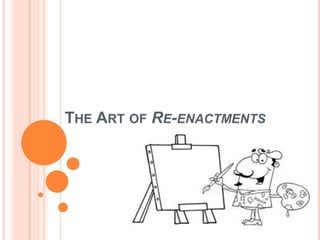
The art of re enactments
- 1. THE ART OF RE-ENACTMENTS
- 2. INITIAL IDEAS Historical re-enactment is the most common type of re-enactment where people might go in a field and dramatically act our a battle from the past. Re-enacting a person who has suffered and recovered from an eating disorder is a little harder! What needs to be kept in mind: - From our textual analysis of Thin, much of there footage took place in a hospital. ‘Thin’ could have easily been an actress, who has been digitally alerted to look thin and perform, this is unlikely but gives me some ideas on how to re-enact a story. Our re-enactment would not involve as much, such as interviews, and would not be as long but brief. - A storyline: The actress, aged 16-18 could be looking at Tumblr on Facebook one day and come across a pro-ana website and then give herself a glance over. She could then she videoed standing on some weighing scales. Footage of her looking at pro ana sites could be used numerous times to show her growing obsession with the sites, and well as her repeatedly standing on scales Then we could show her extreme dieting, a change it what she eats, possibly her hiding food or throwing up, this however is up to discussion as it may make our audience uncomfortable. Hiding in her room, constantly looking in the mirror..then using the editing room show her looking in the mirror but she only ever see’s a large girl, not what she really looks like. Then possibly footage of a hospital, the emergency, rushing in..not necessarily using the actress for this part.
- 3. http://genealogy.about.com/od/wars/a/reenacting.htm has given me a little bit of advice on how to re-enact in general. You are taking something that has already been done, for example there are many movies and documentaries that focus on disorders, take note what is conventionally shown and re- enact as such. ‘In reenactment, a persona is the character and role that you choose to portray. The persona is sometimes referred to as an impression. Depending upon your reenactment scenario, this may be a real individual, or a fictional one who could have lived during your time period of interest.’ ’you need to learn everything you can - from the way they dressed and ate, to their manner of speech, cultural beliefs, and social interactions. ’ – of a person with an eating disorder.